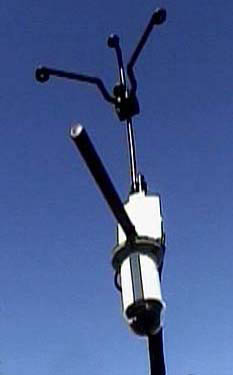

Big Brother isn't just watching the bad guys in Chicago. By late summer, he'll be listening as well -- for the sound of gunshots. Gunshot detection technology -- capable of "triangulating within 20 feet" the location of a shooting -- is being added to 30 surveillance cameras already in place on high-crime corners and to 50 new cameras expected to be installed by late summer at undisclosed locations. Instead of televising only to a portable suitcase monitored by police officers at the scene, the cameras will also be equipped with microwave antennas that beam pictures back to the 911 emergency center and to police headquarters.
Like the initial $750,000 camera experiment, the $2.8 million expansion and upgrade is being paid for with drug forfeiture money. Drug dealers are literally paying for police to breathe down their necks. If there were enough dirty money to go around, Mayor Daley said he would love to see cameras installed on every street corner in Chicago. "In America, there's no such thing as a police state. . . . It's a public way. . . . You want safety in public ways," Daley said Tuesday.
Assistant Deputy Supt. Ron Huberman, who helped design the street-corner cameras tailor-made for Chicago, predicted the high-tech improvements would "greatly decrease" police response times when shootings occur. Within five seconds of a gunshot, a high-pitched alarm will sound alerting the 911 center to the number of shots fired and to an address within 20 feet of the location.
"If you think of the difference of someone having to decide to call 911, pick up the phone, have it go to a calltaker who transmits it to a dispatcher who transmits it to police, we're cutting many steps out of the process," Huberman said. A Chicago Police Department that once included an infamous Red Squad was "extremely concerned about . . . the perception that anyone may have this is Big Brother," Huberman said. "This device does not have the capacity to record any discussion on the public way or to pick up any audio."
Last summer, Chicago dove head-first into the brave new world of policing by installing 30 surveillance cameras on street corners of high-crime neighborhoods. During the first seven months of "Operation Disruption," calls for service in the areas surrounding the 30 cameras dropped by 44 percent. Narcotics calls for service are down 76 percent. Serious crime is down 17 percent and other crimes are down 46 percent.
In the beats lucky enough to have cameras, arrests for narcotics activity have spiked by 61 percent. Thirty-two times, the detective division has asked to "pull the tape" to assist in arrests. Nellie Joyce Carter, whose 800 block of North Harding was the first to get a surveillance camera, said children once confined to their homes are now free to play outside. "People don't want to be seen on cameras if they're doing something wrong. Even if there is no arrests, the cameras are there being protective of the people."
The cameras, 20 feet above ground on utility poles, are equipped with bulletproof lenses. The reinforced steel microwave antennas that rise 3 to 10 feet above the cameras have no such protection. That means they could become target practice for gangbangers, but only if the bad guys have sharpshooter accuracy and a riverboat gambler's mentality.
"If they don't hit it on the first shot, we're going to send the police there," [Assistant Deputy Supt] Huberman said. "We're going to have the video."
The gunshot detection devices to be installed in Chicago's crime-watching cameras employ a technology similar to a seismograph that measures earthquakes. Circuit boards installed in four corners of each camera identify gunshots by measuring the decibel level of the unique sound made by a bullet traveling through the air at high speed. The sensors are then able to "triangulate within 20 feet" the location of the shooting.
Assistant Deputy Supt. Ron Huberman said the system has been tested with a variety of sounds -- ranging from giant firecrackers and dynamite sticks to breaking glass -- to make certain nothing but a gunshot will trigger the system. "When a bullet travels through air at high speed, it makes a noise as it pierces and spreads the air. It's actually picking up that noise."
(Written by Fran Spielman and published on 7 April 2004.)
By e-mail SCP@notbored.org
By snail mail: SCP c/o NOT BORED! POB 1115, Stuyvesant Station, New York City 10009-9998